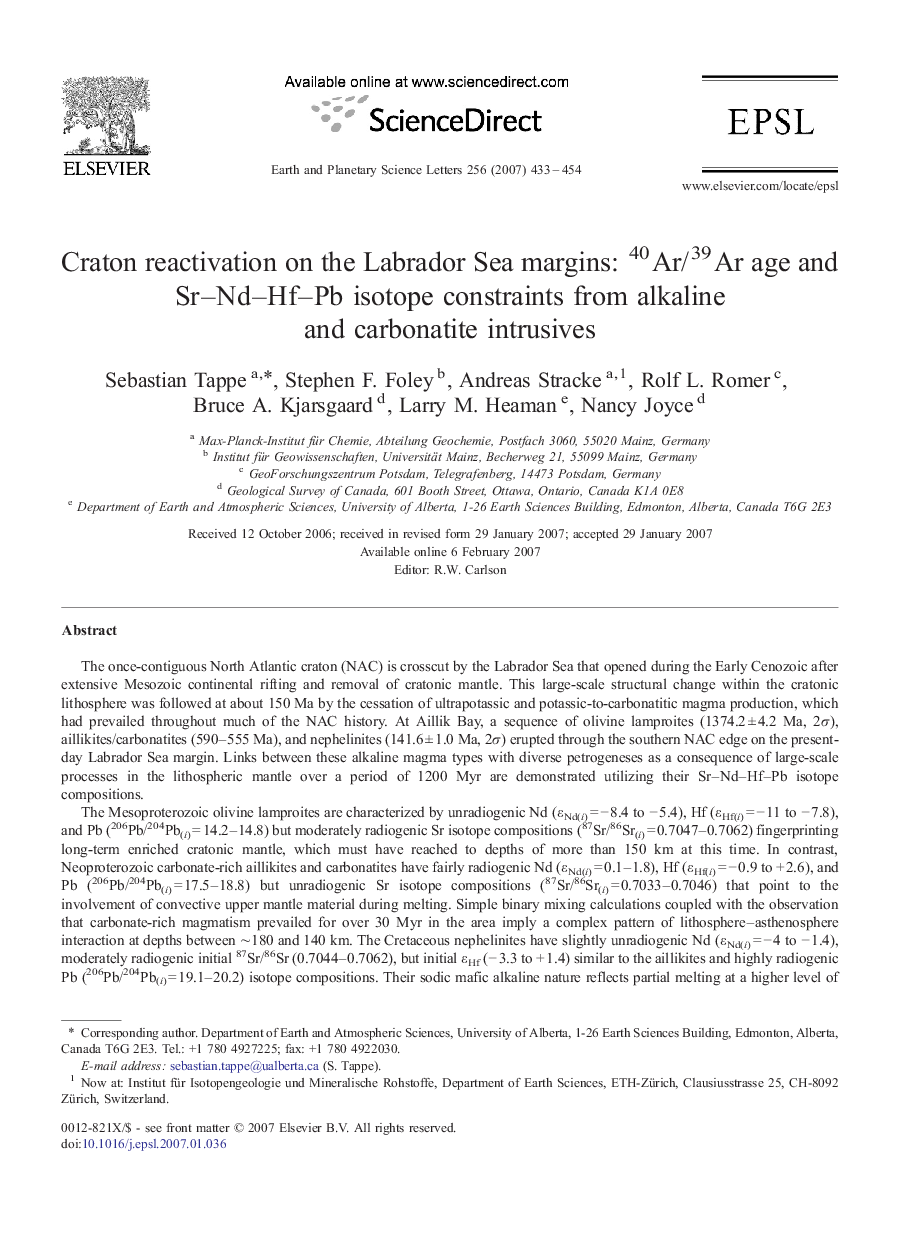| کد مقاله | کد نشریه | سال انتشار | مقاله انگلیسی | نسخه تمام متن |
|---|---|---|---|---|
| 4680591 | 1634922 | 2007 | 22 صفحه PDF | دانلود رایگان |

The once-contiguous North Atlantic craton (NAC) is crosscut by the Labrador Sea that opened during the Early Cenozoic after extensive Mesozoic continental rifting and removal of cratonic mantle. This large-scale structural change within the cratonic lithosphere was followed at about 150 Ma by the cessation of ultrapotassic and potassic-to-carbonatitic magma production, which had prevailed throughout much of the NAC history. At Aillik Bay, a sequence of olivine lamproites (1374.2 ± 4.2 Ma, 2σ), aillikites/carbonatites (590–555 Ma), and nephelinites (141.6 ± 1.0 Ma, 2σ) erupted through the southern NAC edge on the present-day Labrador Sea margin. Links between these alkaline magma types with diverse petrogeneses as a consequence of large-scale processes in the lithospheric mantle over a period of 1200 Myr are demonstrated utilizing their Sr–Nd–Hf–Pb isotope compositions.The Mesoproterozoic olivine lamproites are characterized by unradiogenic Nd (εNd(i) = − 8.4 to − 5.4), Hf (εHf(i) = − 11 to − 7.8), and Pb (206Pb/204Pb(i) = 14.2–14.8) but moderately radiogenic Sr isotope compositions (87Sr/86Sr(i) = 0.7047–0.7062) fingerprinting long-term enriched cratonic mantle, which must have reached to depths of more than 150 km at this time. In contrast, Neoproterozoic carbonate-rich aillikites and carbonatites have fairly radiogenic Nd (εNd(i) = 0.1–1.8), Hf (εHf(i) = − 0.9 to + 2.6), and Pb (206Pb/204Pb(i) = 17.5–18.8) but unradiogenic Sr isotope compositions (87Sr/86Sr(i) = 0.7033–0.7046) that point to the involvement of convective upper mantle material during melting. Simple binary mixing calculations coupled with the observation that carbonate-rich magmatism prevailed for over 30 Myr in the area imply a complex pattern of lithosphere–asthenosphere interaction at depths between ∼180 and 140 km. The Cretaceous nephelinites have slightly unradiogenic Nd (εNd(i) = − 4 to − 1.4), moderately radiogenic initial 87Sr/86Sr (0.7044–0.7062), but initial εHf (− 3.3 to + 1.4) similar to the aillikites and highly radiogenic Pb (206Pb/204Pb(i) = 19.1–20.2) isotope compositions. Their sodic mafic alkaline nature reflects partial melting at a higher level of the cratonic mantle tapping metasomatic components that had been introduced during the > 30 Myr of Neoproterozoic aillikite/carbonatite magmatism.The new 40Ar/39Ar age and Sr–Nd–Hf–Pb isotope data, along with petrological arguments, suggest that at least 30 km of the cratonic mantle beneath the southern NAC edge had been replaced by the hotter upwelling asthenosphere between ca. 550 Ma, when a thick diamond-bearing lithosphere was present, and 150 Ma. This lithospheric thinning presumably occurred shortly prior to Cretaceous continental rifting in response to enhanced plate-tectonic stresses focused at this zone of persistent lithospheric weakness. It appears, however, that the recurrent volatile-rich alkaline magmatism and associated mantle metasomatism played an important role in destroying the structural integrity of the cratonic mantle thereby aiding the subsequent lithosphere thinning.
Journal: Earth and Planetary Science Letters - Volume 256, Issues 3–4, 30 April 2007, Pages 433–454